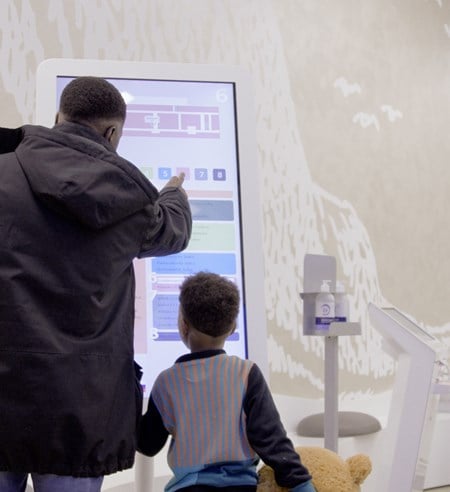Lead Product Manager, Tietoevry Care
The challenge
More and more services are being digitalized to make daily life easier. At the same time, there's a widening gap between people who have climbed aboard the digitalization train and the people who against their will have been left behind. This divide should give us all pause for thought. Who has the responsibility of making sure that everyone gets onboard? Does that task fall on the people left standing on the platform or on the people who have designed and built the train?
In the spring of 2020, the local government in Skellefteå Municipality came to Tietoevry and presented a problem. How to enable persons with cognitive and/or physical limitations, who cannot use an app or other digital services, to clock in and out of work using a digital time reporting tool?
The solution
We set up an innovation project in collaboration with Skellefteå's municipal services administration to get to the bottom of the problem. After looking at various potential solutions, we put two ideas to the test with the help of a user reference group.
The innovation project led to the development of a prototype that we have named TIDA (pronounced tee-da), derived from the Swedish term for time reporting. TIDA helps automise the process of time reporting and ensures correct remuneration for users with cognitive and/or physical limitations who take part in the daily service operations of the municipality as a work training.
The IoT solution that lies at the heart of TIDA is both simple and brilliant. Each user has their own "smart panel" which the user pushes back and forth as they come and go. Sliding the panel activates a wireless signal to a system that logs the time. The panels are somewhat similar to the slider plates marked "occupied" that used to be installed outside conference rooms in the past. In the case of the TIDA, the smart panels can be modified to meet each user's individual needs.
TIDA will also be fitted with a feedback display connected to the smart panel, a user app for when they are at their individual work placements, and an administrative interface for the municipal staff.
TIDA will fall under our Lifecare product range where the solution will be developed further, offering an automated process for the collection and management of the user group's time reporting.
The product name TIDA, pronounced tee-da, will hopefully become a verb that is used in everyday communication across the country. For example, when staff ask a user "Have you tee-da't today?" The combination of analogue components and digital solutions was the key to making this project successful.
About the customer
According to statistics from 2020, some 73,000 people live in Skellefteå Municipality, which employs 7,000 public servants and support staff. An additional 400 people take part in what is known as "rehabilitative support".
Time reporting
Up to 80 percent of the user target group can now do their own time reporting without assistance. The remaining user group members are able to do so with the help of staff.
Manual processes
Replacing a manual process with this digital solution is expected to lead to a 60-percent reduction in the time previously spent on administrator tasks concerning LSS.
Learning tool
TIDA also functions as a learning tool for the users, for example by making the connection between time reporting and remuneration easier to understand.
A digital solution that includes everyone

Video is blocked
If clients in Daily activities are able to perform their own time registration, their independence increases. In addition, a more efficient and automated process frees up capacity for professionals to focus on their clients’ development.
Carina Norman, Skellefteå Municipality
Business developer on Socialkontoret
About the innovation project
Goal: To automate time-intensive, manual municipal tasks, to support the development of the participants’ autonomy, to increase their participation in daily services operations and to create a useful learning tool for the staff.
Target group: We worked with people who are often overlooked in the ongoing digitalisation of society, despite having just as much to benefit from new technology as everyone else. Members of the target group all have cognitive and/or physical impairments, which means they need extra support in their daily lives.
Understanding the target group: To make sure the solution was functional we spent a lot of time during the start-up phase together with the target group in relevant contexts in order to understand their needs, their capacities and their work environments.
Subsequently, we worked closely with the target group members and municipal staff to discuss various proposals and solutions. Two solutions were selected: An analogue solution combined with IoT and a mobile app.
Twelve weeks were then dedicated to the prototype phase for development, testing and iteration so we could gather information about whether the solution met the target group’s needs and thereafter make adjustments accordingly.
Lessons learned: At an early stage, we understood that there was great variation of both the needs and the abilities among members of the broad target group. Some have physical disabilities that affect their mobility, which limit their ability to use even simple analogue solutions. Others faced challenges in using basic digital solutions. This range of challenges meant that a successful solution had to combine analogue and digital functions.
There needed to be possibilities to adjust the solution and to find appropriate tools in order to develop a workable solution that could be extended to similar target groups that also risk digital exclusion. The development of functionable tools hinges on paying closer attention to and showing more consideration towards these groups.
While new EU directives on accessibility will be of support to inclusivity projects, local and regional governments as well as IT providers need to continuously develop better solutions. The mindset that a single digital solution is enough needs to change.
It is estimated that on average each Swedish municipality spends 10 minutes per client per month only on registering clients’ working hours. Additional checks, changes, payments, and other routines are not included in those 10 minutes. This means that a mid-size municipality like Skellefteå with approximately 400 clients, spends about 800 hours per year, just on the first part of the process.
Sara Hedman
Innovation Designer
What’s next?
Tietoevry’s development of TIDA as a Lifecare product is set to commence in the summer of 2022.
TIDA and the UN:s 2030 sustainable development goals
Tietoevry and Skellefteå have been chosen as finalists for the CIO Awards 2021, which recognize and reward sustainability projects.
The TIDA project’s focus on the creation of an inclusive solution for a digitally excluded target group has successfully addressed several of the UN:s 2030 sustainability goals.
GOAL 4: Quality Education
GOAL 8: Decent Work and Economic Growth
GOAL 10: Reduced Inequality
Would you like to know more?
For more information about the project and the solution, please contact Jahn Sundin, Jahn.Sundin@tietoevry.com.





